Property Newsletter | October 2021
PE in focus
The friendly city follows trend towards sectional title and estate living and house price inflation exceeds the national average
The number of Freehold, Sectional Title and Estate units have more than doubled in Gqeberha, formerly known as Port Elizabeth, since 1994, from 42 122 to 89 773 at the end of Q3 in 2021.
This data excludes RDP and informal housing.
As in many other cities around South Africa, Estate and Sectional Title living have become increasingly popular over the past 27 years. Freehold property stock has declined in popularity although it remains the dominant residential property class in Gqeberha, the country’s sixth largest city and the Eastern Cape’s economic and financial hub.
Stock pre and post 1994
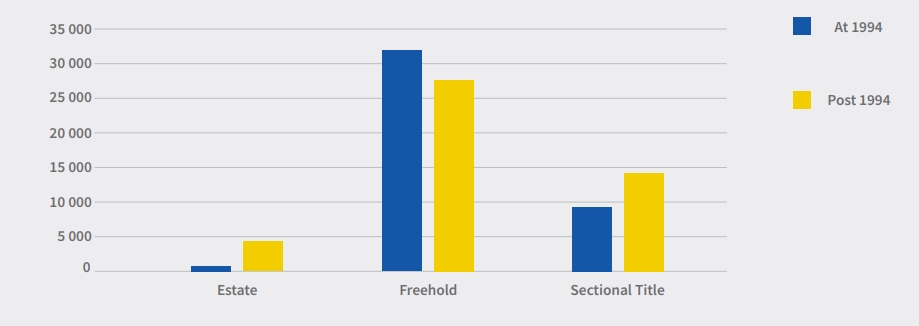
The graph above demonstrates that in 1994 Estate living was a rarity with just 318 units, but by 2021 another 4 609 units have been added. There were 9 283 Sectional Title units in 1994, and another 14 542 have been added since then, bringing the city’s total stock to 23 825. PE, as the town is colloquially known, had 32 521 Freehold properties in 1994, and although growth has slowed proportionately, another 28 500 have been introduced since then.
The bulk of residential property development in the city (65%) has taken place in two phases – in the years after the first democratic government was elected, and again in the mid-2000s.
Of the 37 044 units added since 1994, 13 223 (36%) were added by the end of 2000. Development slowed from 2001 to 2003, but then picked up again between 2004 to 2008, when 10 633 units (29%) were developed.
Development has slowed in recent years, with 2021 at 477 just two better off than the 475 recorded in 2010, the worst year on record since 1997. Interestingly, Sectional Title developments have led the way in the last four years.
Development of property since 1994
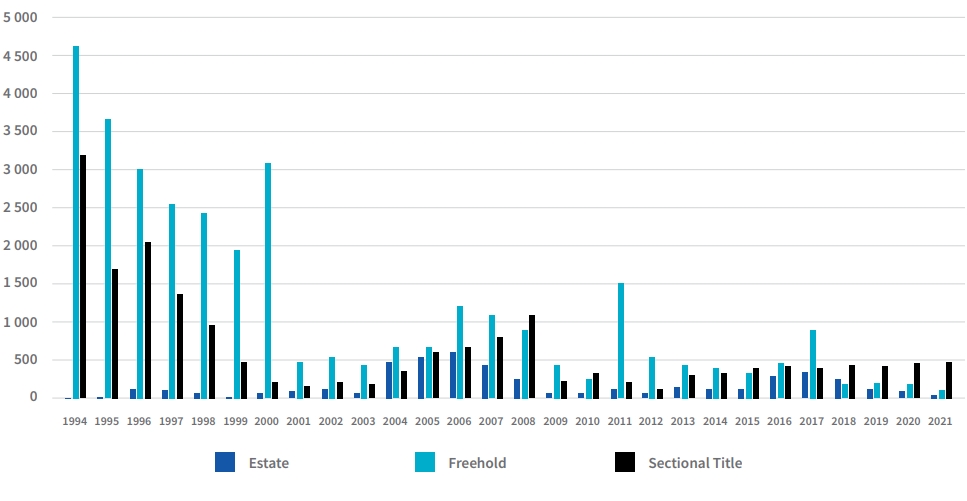
Development in suburbs since 1995
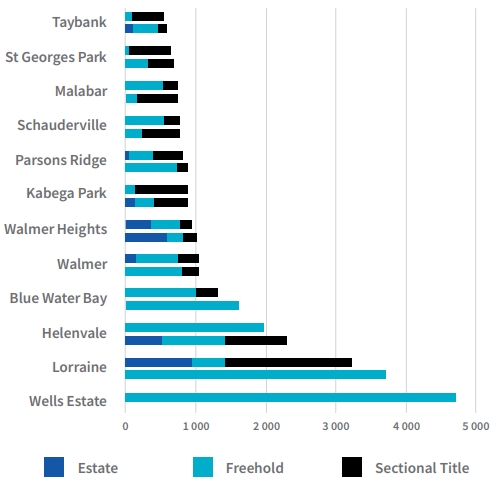
The bulk of Freehold development has taken place in Wells Estate, along the N2 towards Makhanda (Grahamstown) and in Walmer Township, followed by Helenvale and Greenbushes. The bulk of Sectional Title and Estate units has taken place in Lorraine, one of the fastest growing suburbs in the city. It is west of the CBD and close to Kragga Kamma Park and Lovemore Heights.
Volume of transactions
Just as development has slowed in recent years, so too have transfer volumes although Covid-19 may well explain the reduced level of activity in 2020 and 2021 after a five year high in 2019. Notably, transfer volumes were relatively high until the recession of 2008/9.

The current value of stock in Gqeberha sits in three value bands, from R700 000 to R3 million.
Value of stock
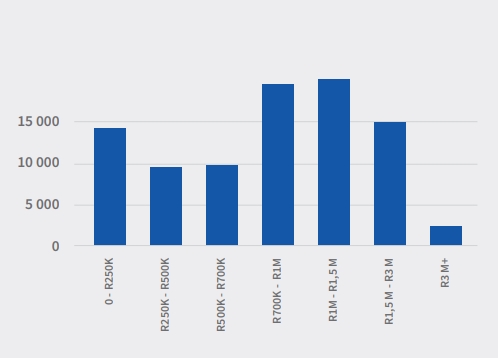
Current new stock
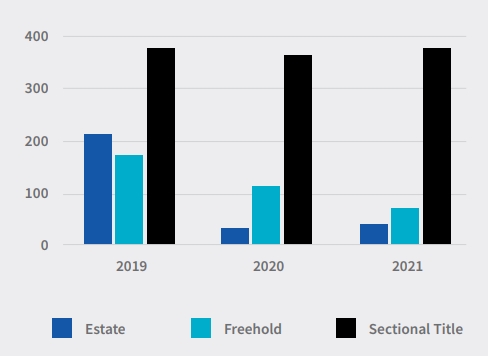
Of the current stock available from 2019 to 2021, Sectional Title accounts for (62%) 1 098 units out of 1 764, Freehold for 368 units (21%) and Estates for 298 (17%).
Migration to PE
The vast majority of people moving to PE are from elsewhere in the province, as the graph below demonstrates. Other than relatively modest numbers from Gauteng and the Western Cape, the graphs suggest PE is not attracting residents from other provinces as it might.
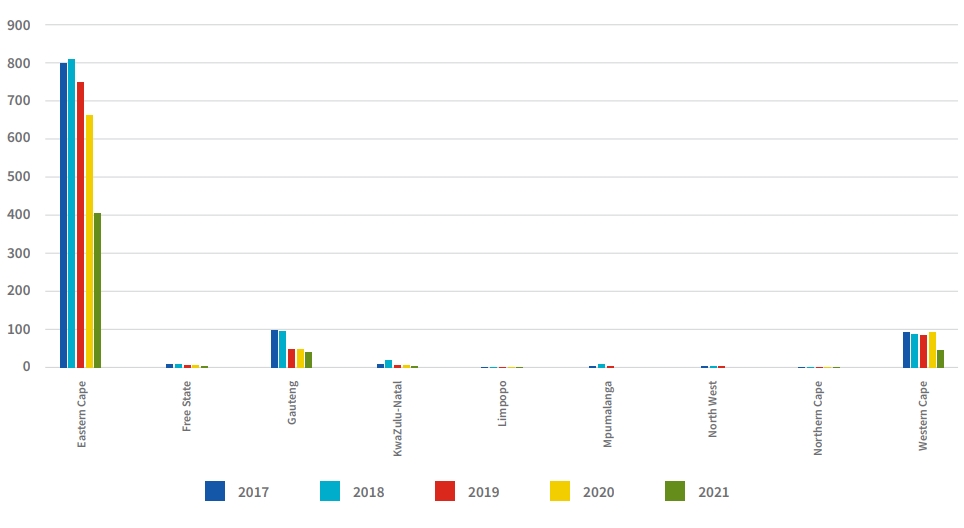
The graph below excludes those moving from within the Eastern Cape – and of those moving to PE from a different province, most are arriving from Gauteng and the Western Cape.
Moving from PE: To a different province
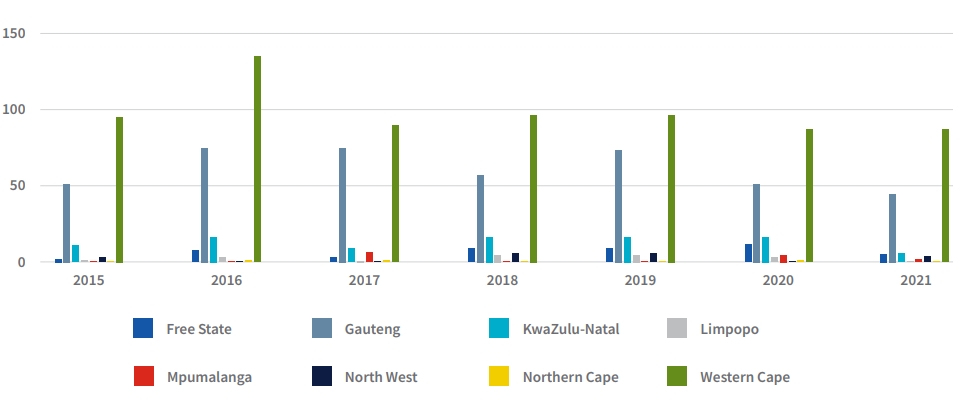
Most buyers moving to PE are between the ages of 35-64, and buying mostly in the high value, mid value and luxury / wealthy bands
Age of buyers moving to PE
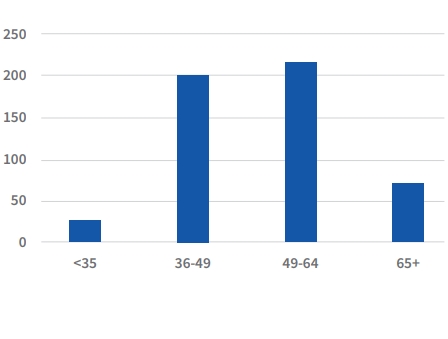
Volume per value segment moving to PE
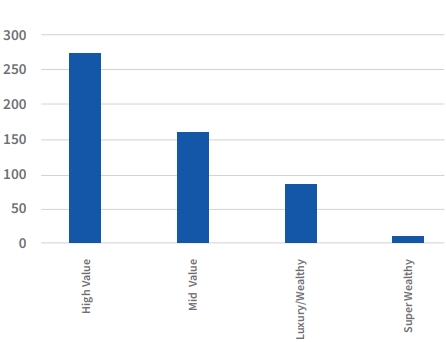
Perhaps because of the slowing of development and relatively little influx from other provinces, property price inflation in the Nelson Mandela Bay Municipality (which includes Gqeberha, Kariega (formerly Uitenhage) and Despatch is tracking above the national average (see graph below) since the last quarter of 2017.
Nelson Mandela Bay inflation compared to national inflation
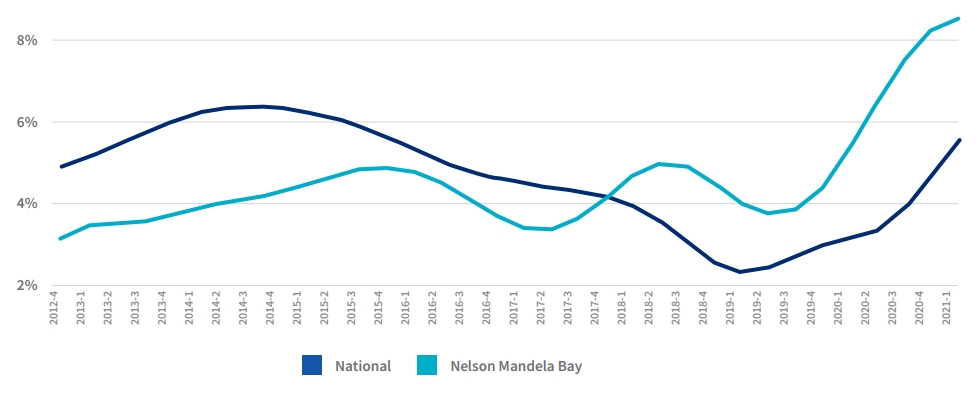
Interestingly, first time buyers make up a higher proportion of buyers in 2020 and 2021, perhaps because of the low interest rates introduced to help alleviate the impact of Covid-19.
First time home buyers vs repeat buyers
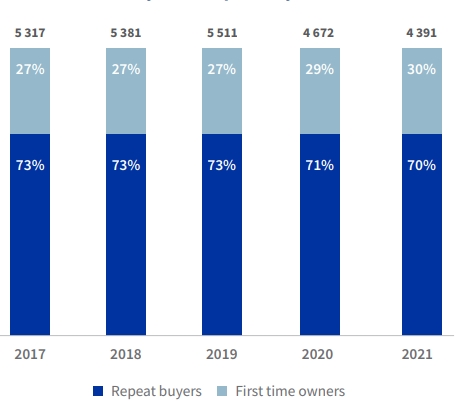
Volume of first time home buyers
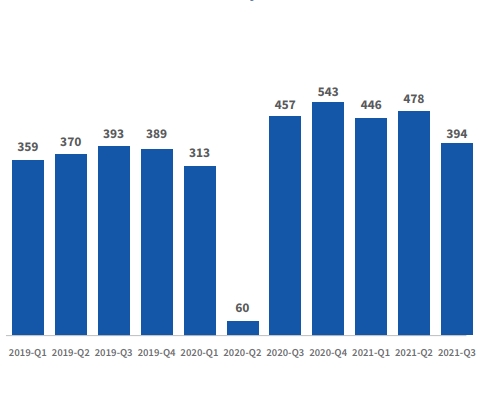
Summary of top suburb transfers per category
Top suburbs by transfers: Freehold
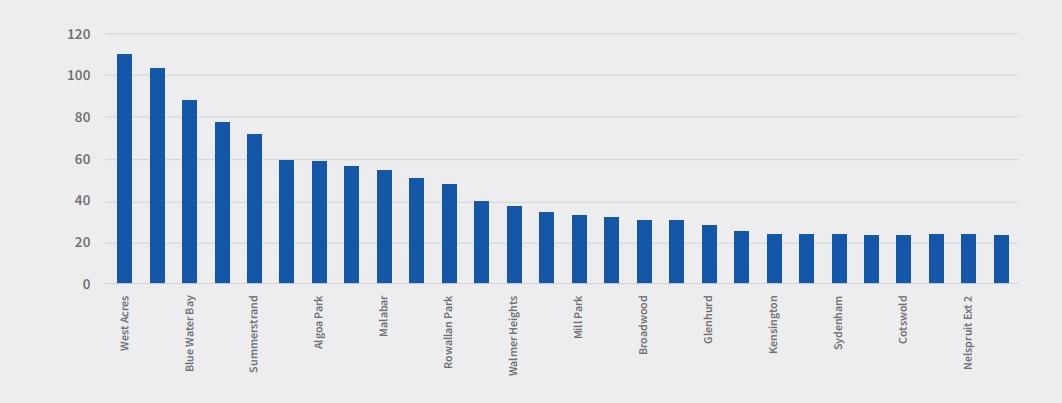
Top suburbs by transfers: Estate
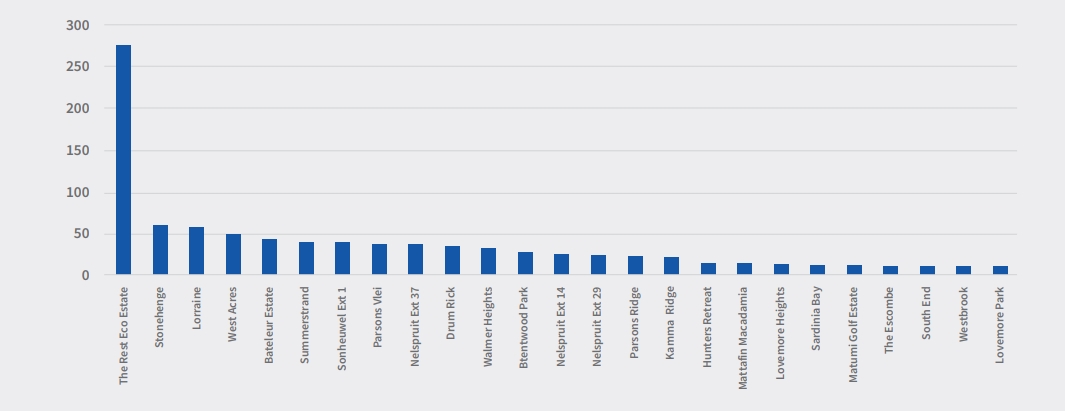
Top suburbs by transfers: Sectional Title
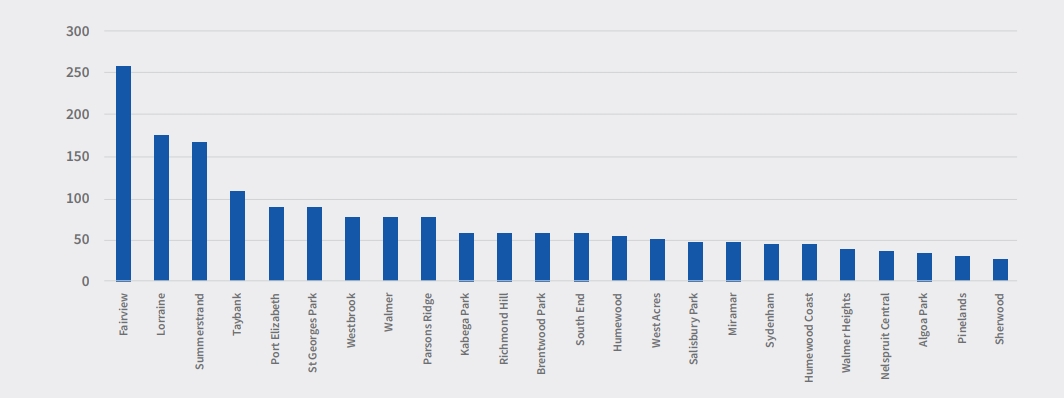
Did you know
Now officially Gqeberha, previously known as Port Elizabeth but also nicknamed PE, the friendly city, the windy city and the 10 minute city, the second oldest colonial city in South Africa is well known for its 40km of unspoilt coastline, its port and harbour and as a popular stopover for those travelling to the Garden Route.
But did you know that the city is home to the oldest bowling green and the oldest cricket club in South Africa and that it is home to the oldest and still active theatre on the continent, which was renamed the Nelson Mandela Theatre Complex (previously the Port Elizabeth Opera House) on the 31st of May this year.
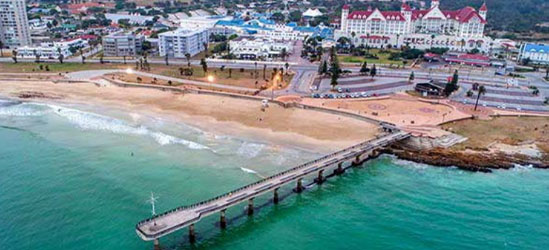
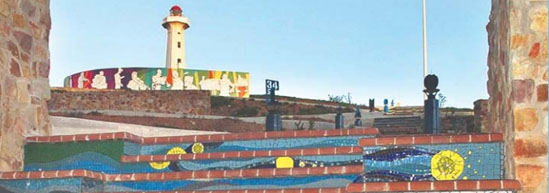
Forget Route 66, it’s all about Route 67
And next time you’re passing through, take the time to visit Route 67. It is a collection of 67 public art works celebrating Nelson Mandela’s 67 years of work dedicated to the Freedom of South Africa. The collection includes 67 steps leading up to the second largest flag in Africa and exhibits visual arts, urban design and heritage.
Other key findings included:
- Movement to and from small towns like Margate, Mossel Bay, Milneton and Jeffery's Bay is on the increase;
- The state of the economy is telling in the number of people downgrading as opposed to upgrading;
- A trend towards Estate living in the R1m-R3m market.
The presentation on semigration – when a buyer sells a property and purchases a new one in a new province – also assessed who was moving and why.
South Africa’s formal property stock volumes sit at 6.8m and is valued at R6.1 trillion. Gauteng accounts for the bulk of the stock (35%) and value (38%), but the demand for properties in the Western Cape is evident in that it accounts for 18% of the stock but 29% of the value. KwaZulu-Natal is next at 13% for both stock and value. In all the other six provinces, the value of the stock is less, in percentage terms, than the total stock volume.

Solutions that simplify the complex
Our new website makes it easier to navigate and discover a range of Lightstone products and solutions that make it easier for you to do business.

One place to access your subscriptions
We’ve simplified the complex with a single sign on functionality. Simply login and you will have access to all the products that you currently subscribe to. All in one portal.

What’s happening to the old website?
A few links on our new website may redirect you to certain pages on the old website. This is just a temporary solution to ensure legacy users still have access to certain products.

.png)
.png)
.png)
.png)